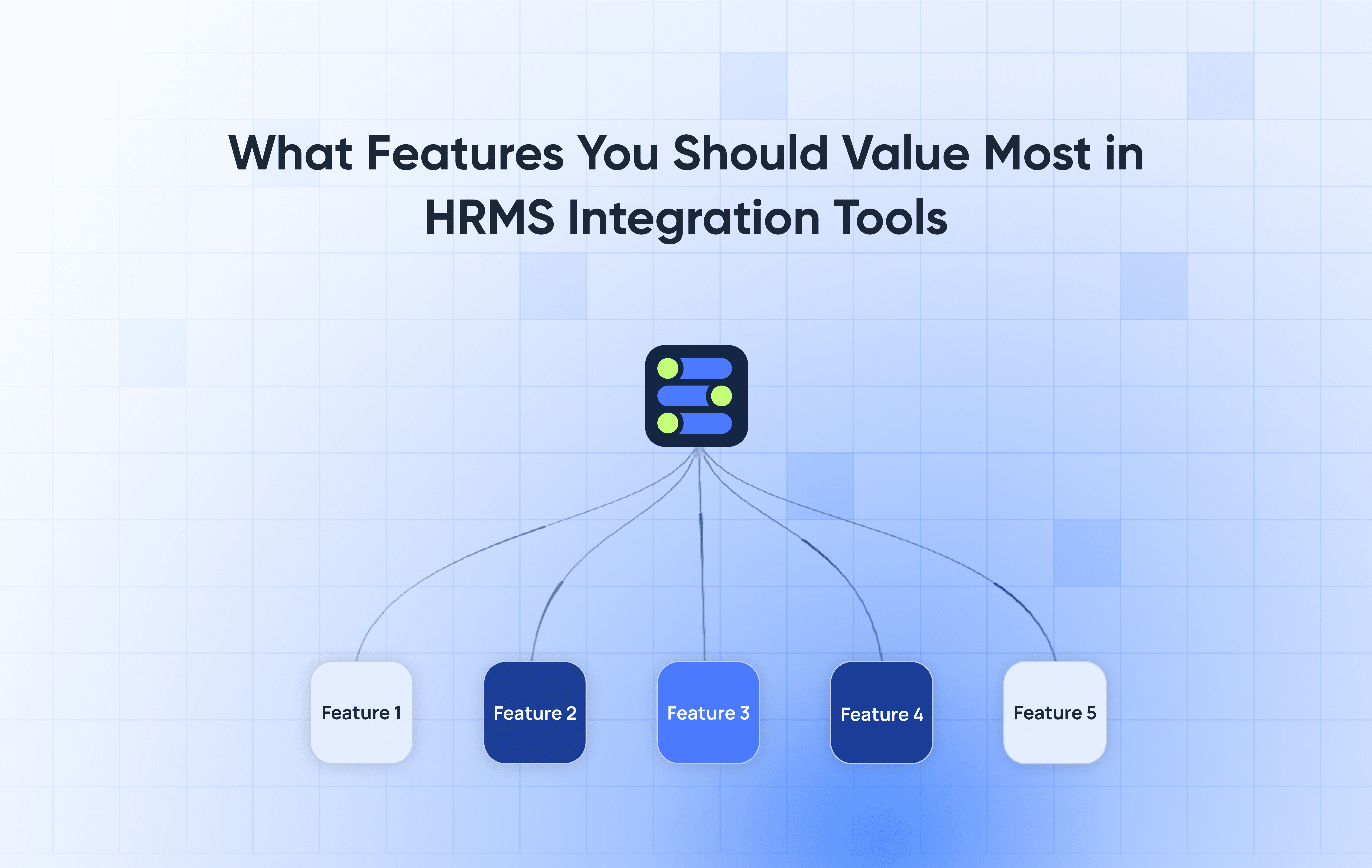
Oct 17, 2024
What Features You Should Value Most in HRMS Integration Tools
HRMS integration is essential for businesses that want to streamline operations, reduce manual interventions, and improve efficiency by seamlessly connecting their client’s HRMS (Human Resource Management System) with their business systems and applications. As organizations grow and expand their technological infrastructure, integrating HR systems with business-critical applications—such as payroll, employee management, or compliance tools—becomes a strategic necessity.
Let’s explore the key features to prioritize when selecting the best integration solution for your organization.
1. Unified API for Seamless Integration
A unified API is a crucial feature for HRMS integrations. It acts as a central point of communication between various systems, streamlining the integration process with multiple HRMS platforms and reducing the need for individual integration efforts for each platform.
With HRMS Sync, businesses can access over 70 HR management systems via a single API. This wide-ranging integration capability is ideal for businesses that need flexibility to connect with various HR platforms. HRMS Sync eliminates manual CSV data import’s tedious and time-consuming process by offering real-time connectivity, ensuring that employee data is always current. Moreover, it handles diverse data types, from payroll details to employee benefits and onboarding information, making it a highly versatile solution.
2. Customizable Data Fetching and Mapping
Customizable data handling is another critical feature, as different industries and organizations have unique data needs. The ability to select and fetch only the required data points—such as employee status, promotions, salary adjustments, or terminations—enhances the integration’s efficiency.
HRMS Sync offers customizable data fetching, which enables businesses to specify what data to share based on their unique requirements. This tailored approach reduces unnecessary data transmission, optimizing system performance. Additionally, its seamless data mapping ensures that information from various HRMS platforms is standardized, minimizing the risk of miscommunication or data errors across systems. For example, HRMS Sync supports CSV uploads and SFTP integrations, making it adaptable to different organizations’ technical needs.
3. Real-time Data Syncing
One of the most valuable features of an HRMS integration tool is real-time data syncing. This is especially critical for industries where immediate updates in employee information—such as payroll, insurance, or compliance management—are necessary to avoid service delays or inaccuracies.
HRMS Sync provides real-time updates, ensuring that service providers such as insurance companies or banks have access to the latest employee information. This is invaluable in scenarios where timely updates are critical, like when an employee's status changes or compliance regulations require immediate reporting of personnel data. The continuous data sync capabilities in HRMS Sync enhance service reliability by reducing the turnaround times that come with manual data updates, ultimately ensuring that businesses operate more efficiently.
4. Security and Compliance
Given the sensitive nature of employee data, any integration tool must prioritize security and compliance. Your integration should comply with global standards, ensuring all data transfers are secure and encrypted.
HRMS Sync utilizes one of the most robust encryption standards. This protects employee data from potential breaches or unauthorized access during system transfers. In addition to encryption, HRMS Sync fully complies with regulations, which is crucial for businesses operating in data-sensitive industries like insurance and banking. The built-in rule engine in HRMS Sync also allows companies to configure automated processes that align with regulatory requirements, ensuring compliance is maintained across all integrations.
5. Automated Error Handling and Rule Engine
Manual processes are often riddled with human errors, leading to significant operational disruptions. An effective HRMS integration tool should feature automated error handling to identify and rectify issues without requiring constant human oversight.
HRMS Sync has an advanced rule engine that allows businesses to automate data processes. For instance, service providers can configure specific rules to trigger actions when data discrepancies are detected, automatically resolving them before they affect downstream systems. This reduces the dependency on human intervention, improving both accuracy and efficiency. Furthermore, the system can send real-time alerts to notify stakeholders of errors or integration issues, helping businesses maintain seamless operations with minimal downtime.
6. Scalability and Flexibility
An HRMS integration tool should meet your current needs and scale with your business as it grows. The ability to add new HRMS platforms, accommodate increasing data volumes, and adapt to changing business requirements is essential for long-term success.
HRMS Sync is designed for scalability, making it ideal for small and large businesses. As organizations grow, the number of HRMS systems they interact with may increase, along with the complexity of their data needs. HRMS Sync can handle these demands, allowing companies to seamlessly add new HRMS platforms and scale up their integration efforts without compromising performance. Its flexible architecture enables integration with other business-critical applications beyond HRMS, such as payroll, finance, and operations systems.
7. Sync Frequency and Performance Monitoring
Sync frequency is a significant consideration for businesses dealing with dynamic data environments. Whether managing real-time employee onboarding, processing payroll, or tracking compliance changes, having a tool that supports frequent syncing is critical.
With HRMS Sync, organizations can choose the sync frequency that best meets their operational needs. The tool offers real-time data updates and periodic sync options, depending on the specific integration requirements. Additionally, HRMS Sync provides detailed monitoring and reporting tools that allow businesses to track the performance of their integrations, identify bottlenecks, and optimize sync settings to ensure maximum efficiency.
Conclusion
Choosing the right HRMS integration tool is critical to your organization’s productivity and efficiency. While there are several factors to consider, features like unified API access, real-time data syncing, security and compliance, scalability, and customizable data handling should be at the top of mind. HRMS Sync is a powerful solution that checks all these boxes, offering a robust, secure, and scalable platform that can meet the diverse needs of businesses across industries.
By prioritizing these key features, businesses can streamline their HR operations, improve data accuracy, and remain compliant with ever-changing regulations. HRMS Sync simplifies the integration process and enhances the overall reliability of business operations, making it an invaluable asset for any organization looking to optimize its HR management capabilities.
Click here for a free DEMO of HRMS Sync.
Pramey Jain
CEO & Founder




